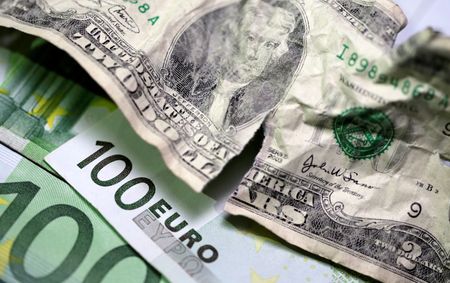
By Iain Withers
LONDON (Reuters) -The euro was on track on Friday for its best week versus the dollar since the COVID-19 pandemic hit, after a hawkish turn by the European Central Bank (ECB) rippled through markets.
Rampant inflation across many global economies has forced central banks to tighten monetary policies that had been dramatically loosened to help consumers and businesses weather the financial hit from the pandemic.
The ECB had resisted the tide. But on Thursday, despite holding rates in negative territory, President Christine Lagarde acknowledged mounting inflation risks and opened the door to potential rate hikes later this year.
Investment banks subsequently brought forward their calls on rate hikes, with Goldman Sachs analysts saying they expected an increase of 25 bps each in September and December, putting the ECB’s policy rate at 0% by the end of the year.
“That the ECB has now signalled a more urgent path towards hiking rates for the first time in a decade is… of ground-breaking importance,” Deutsche Bank currency analysts said in a note.
“Europe has lived with negative rates for nearly a decade… When the ECB signals that this can change, it matters. It will take a long time for the full impact to be realized, and we should expect a few surprises along the way.”
The euro has gained three cents against the dollar this week to stand just shy of $1.15 – its best weekly gain since March 2020. It strengthened 0.4% on the day to $1.14830, close to a 12-week high, and was last up 0.3%.
The euro’s strength has been reflected in dollar index weakness – as it tracks the greenback against six major rivals including the euro.
The dollar index is on track for around a 2% weekly slide, its worst performance since the pandemic hit. It was last at 95.227.
U.S. employment data is due later on Friday, which could give investors clues as to how quickly the Federal Reserve will tighten policy. The markets are now factoring in as many as five U.S. rate hikes this year.
Sterling also has been among the big currency movers this week, after the Bank of England raised rates to 0.5% on Thursday – marking the first back-to-back increases by the central bank since 2004.
The pound is on track for a more than 1% weekly gain versus the dollar, although it lost some ground on Friday and was last trading just shy of $1.36.
Safe haven currency the Japanese yen was broadly unchanged on the day, at 114.840 yen per dollar.
Australia’s central bank on Friday sharply revised up its outlook for inflation, but kept policy super loose as it seeks a lasting recovery in wages and living standards.
The Australian dollar lost ground on the day and was last down 0.7% versus the U.S. dollar at $0.70930.
(Reporting by Iain Withers, Additional reporting by Alun John in Hong Kong; Editing by Kim Coghill and Alex Richardson)

